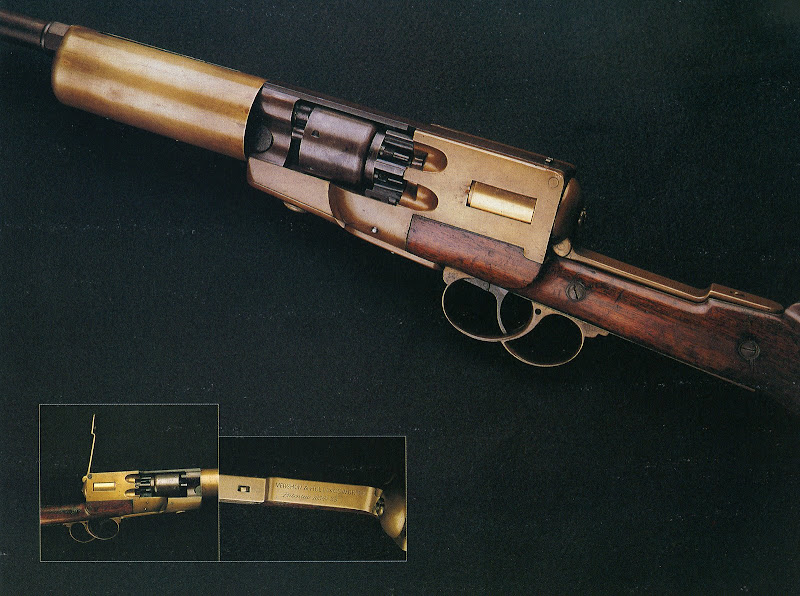Goodness, what a lot of things to talk about here. But it's good to hear people thinking (!) about new ideas for old things. I have a few comments.
The original subject, a harmonica-fed weapon, is novel to be sure, but in a way, the harmonica part is just the cylinder flattened out, so to speak. It can certainly be considered a muzzle-loader as long as it loads from the front, even though there were metallic cartridges that loaded from the front, too, but those were mainly transitional applications until S&W patents ran out. At any rate, I'm not sure the harmonica arrangement has any particular advantage over a cylinder (which is the same thing rolled up, if you follow me). In fact, the biggest disadvantage is that you have something that sticks out on one side--and then the other. This disadvantage appears in any other firearm with a side mounted magazine and there have been a few over the years, so maybe it isn't the disadvantage I imagine it is. However, I'm thinking more along the lines of a shoulder fired weapon, rather than a heavy tripod or carraige mounted affair. Merely a matter of scale.
You would have to have a system to engage the charger (let's call it a charger) when the gun is loaded. Minor detail. But keep in mind that there is a fine line between something that works and something that doesn't. That applies to modern firearms, too.
If this beast is to be semi-automatic, I'd say that some major redesign of the moving parts might be in order. Civil War period weapons were not expected to be operated at high speed, and neither were the early cartridge revolvers. Ask anyone who's done a lot of fanning with their Single Action Army. It's more a question of design than anything else.
But don't give up hope. There is always something appealing about things like this and the gun world is full of them, even though most of them only seem that way at the distance of 75 or 100 years, like for example, a pistol with a fixed magazine charged with stripper clips. Seen one of them lately?
Seeing the photos from the movie, if that's what it was, it suggests to me that the idea is a natural for a slide-action (pump action) rifle. You could utilize the harmonica charger, keep it at five or six rounds and it's a natural for primative hunting, right up there with a slur bow. Remember, someone invented a repeating crossbow in time to be used in the Russo-Japanese war, only I don't remember which side tried it out.
The original subject, a harmonica-fed weapon, is novel to be sure, but in a way, the harmonica part is just the cylinder flattened out, so to speak. It can certainly be considered a muzzle-loader as long as it loads from the front, even though there were metallic cartridges that loaded from the front, too, but those were mainly transitional applications until S&W patents ran out. At any rate, I'm not sure the harmonica arrangement has any particular advantage over a cylinder (which is the same thing rolled up, if you follow me). In fact, the biggest disadvantage is that you have something that sticks out on one side--and then the other. This disadvantage appears in any other firearm with a side mounted magazine and there have been a few over the years, so maybe it isn't the disadvantage I imagine it is. However, I'm thinking more along the lines of a shoulder fired weapon, rather than a heavy tripod or carraige mounted affair. Merely a matter of scale.
You would have to have a system to engage the charger (let's call it a charger) when the gun is loaded. Minor detail. But keep in mind that there is a fine line between something that works and something that doesn't. That applies to modern firearms, too.
If this beast is to be semi-automatic, I'd say that some major redesign of the moving parts might be in order. Civil War period weapons were not expected to be operated at high speed, and neither were the early cartridge revolvers. Ask anyone who's done a lot of fanning with their Single Action Army. It's more a question of design than anything else.
But don't give up hope. There is always something appealing about things like this and the gun world is full of them, even though most of them only seem that way at the distance of 75 or 100 years, like for example, a pistol with a fixed magazine charged with stripper clips. Seen one of them lately?
Seeing the photos from the movie, if that's what it was, it suggests to me that the idea is a natural for a slide-action (pump action) rifle. You could utilize the harmonica charger, keep it at five or six rounds and it's a natural for primative hunting, right up there with a slur bow. Remember, someone invented a repeating crossbow in time to be used in the Russo-Japanese war, only I don't remember which side tried it out.
















